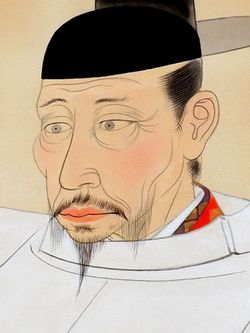
Toyotomi Hideyoshi (豊臣 秀吉, 17 March 1537 – 18 September 1598), otherwise known as Kinoshita Tōkichirō (木下 藤吉郎) and Hashiba Hideyoshi (羽柴 秀吉), was a Japanese samurai and daimyō (feudal lord) of the late Sengoku and Azuchi-Momoyama periods and regarded as the second "Great Unifier" of Japan. Although he came from a peasant background, his immense power earned him the rank and title of Kampaku (関白, Imperial Regent) and Daijō-daijin (太政大臣, Chancellor of the Realm), the highest official position and title in the nobility class. He was the first person in history to become a Kampaku who was not born a noble. He then passed the position and title of Kampaku to his nephew, Toyotomi Hidetsugu. He remained in power as Taikō (太閤), the title of retired Kampaku, until his death. It is believed, but not certain, that the reason he refused or could not obtain the title of shogun (征夷大将軍), the leader of the warrior class, was because he was of peasant origin.
Hideyoshi rose from a peasant background as a retainer of the prominent lord Oda Nobunaga to become one of the most powerful men in Japanese history. Hideyoshi succeeded Nobunaga after the Honnō-ji Incident in 1582 and continued Nobunaga's campaign to unite Japan that led to the closing of the Sengoku period. Hideyoshi became the de facto leader of Japan and acquired the prestigious positions of daijō-daijin and kampaku by the mid-1580s. Hideyoshi launched the Japanese invasions of Korea in 1592 to initial success, but eventual military stalemate damaged his prestige before his death in 1598. Hideyoshi's young son and successor Toyotomi Hideyori was displaced by Tokugawa Ieyasu at the Battle of Sekigahara in 1600 which would lead to the founding of the Tokugawa Shogunate.
Hideyoshi's rule covers most of the Azuchi–Momoyama period of Japan, partially named after his castle, Momoyama Castle. Hideyoshi left an influential and lasting legacy in Japan, including Osaka Castle, the Tokugawa class system, the restriction on the possession of weapons to the samurai, and the construction and restoration of many temples, some of which are still visible in Kyoto.
Source : Wikipedia